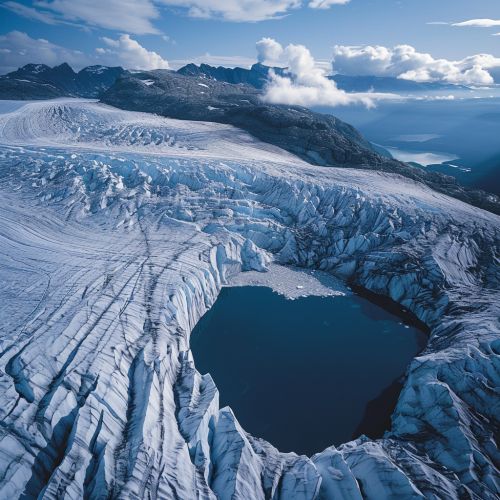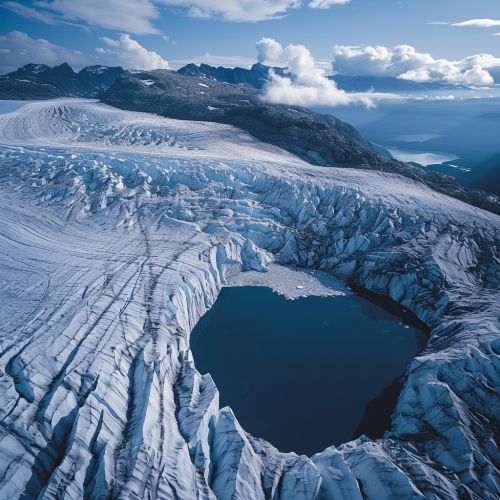Subglacial Lake: Difference between revisions
(Created page with "== Introduction == A **subglacial lake** is a body of water that forms beneath a glacier or ice sheet. These lakes are typically found in polar regions, where thick ice sheets cover the landscape. Subglacial lakes are of significant scientific interest due to their unique environmental conditions, potential to harbor ancient microbial life, and influence on ice dynamics and climate change. == Formation and Characteristics == Subglacial lakes form in areas where the pr...") |
No edit summary |
||
| Line 19: | Line 19: | ||
Subglacial lakes are part of a dynamic hydrological system that includes meltwater channels and subglacial rivers. These water bodies can be interconnected, allowing water to flow between them, which can influence the stability and movement of the overlying ice sheet. | Subglacial lakes are part of a dynamic hydrological system that includes meltwater channels and subglacial rivers. These water bodies can be interconnected, allowing water to flow between them, which can influence the stability and movement of the overlying ice sheet. | ||
[[Image:Detail-97299.jpg|thumb|center|Aerial view of a glacier with a subglacial lake beneath the ice.|class=only_on_mobile]] | |||
[[Image:Detail-97300.jpg|thumb|center|Aerial view of a glacier with a subglacial lake beneath the ice.|class=only_on_desktop]] | |||
== Notable Subglacial Lakes == | == Notable Subglacial Lakes == | ||
Latest revision as of 13:59, 27 July 2024
Introduction
A **subglacial lake** is a body of water that forms beneath a glacier or ice sheet. These lakes are typically found in polar regions, where thick ice sheets cover the landscape. Subglacial lakes are of significant scientific interest due to their unique environmental conditions, potential to harbor ancient microbial life, and influence on ice dynamics and climate change.
Formation and Characteristics
Subglacial lakes form in areas where the pressure from the overlying ice is sufficient to lower the melting point of water, allowing liquid water to exist despite the freezing temperatures. The geothermal heat from the Earth's interior also contributes to the melting of the ice at the base. The water in subglacial lakes is typically isolated from the atmosphere, leading to unique chemical and biological properties.
Geothermal Heat
Geothermal heat flux varies across the Earth's surface and is a critical factor in the formation of subglacial lakes. In regions with higher geothermal heat flux, the base of the ice sheet is more likely to reach the melting point, creating conditions favorable for the formation of subglacial lakes.
Ice Pressure
The immense pressure exerted by the overlying ice sheet lowers the melting point of water, a phenomenon known as pressure melting. This allows liquid water to exist at temperatures below the standard freezing point of 0°C.
Hydrology
Subglacial lakes are part of a dynamic hydrological system that includes meltwater channels and subglacial rivers. These water bodies can be interconnected, allowing water to flow between them, which can influence the stability and movement of the overlying ice sheet.


Notable Subglacial Lakes
Several subglacial lakes have been identified and studied, with Lake Vostok in Antarctica being one of the most well-known.
Lake Vostok
Lake Vostok is the largest subglacial lake in Antarctica, located beneath the East Antarctic Ice Sheet. It is approximately 250 km long, 50 km wide, and has an estimated depth of 500 meters. The lake is covered by about 4 km of ice, which has isolated it from the surface for millions of years. This isolation has led to speculation about the possibility of unique microbial life forms adapted to the extreme conditions.
Lake Whillans
Lake Whillans is another significant subglacial lake located beneath the West Antarctic Ice Sheet. It is smaller than Lake Vostok but has been the focus of extensive scientific research. In 2013, researchers successfully drilled into Lake Whillans and retrieved water and sediment samples, discovering microbial life in the lake.
Lake Ellsworth
Lake Ellsworth, also located in Antarctica, has been the target of scientific drilling projects aimed at exploring its unique environment. The lake lies beneath approximately 3 km of ice and is thought to have been isolated for hundreds of thousands of years.
Scientific Research and Exploration
The exploration of subglacial lakes presents significant technical challenges due to the thick ice cover and extreme environmental conditions. However, advances in drilling technology and remote sensing have enabled scientists to study these hidden ecosystems.
Drilling Techniques
Various drilling techniques have been developed to access subglacial lakes, including hot-water drilling and mechanical drilling. These methods must be carefully managed to avoid contaminating the pristine environments of the lakes.
Remote Sensing
Remote sensing technologies, such as radar and satellite imagery, play a crucial role in identifying and mapping subglacial lakes. These tools allow scientists to study the ice sheet's thickness, structure, and the presence of liquid water beneath it.
Microbial Life
One of the most exciting aspects of subglacial lake research is the potential discovery of unique microbial life forms. The extreme conditions of these lakes, including high pressure, low temperatures, and limited nutrients, provide a unique environment for studying extremophiles and their adaptations.
Implications for Climate Change
Subglacial lakes have significant implications for our understanding of climate change and ice sheet dynamics. The presence of liquid water beneath ice sheets can influence their stability and movement, potentially leading to accelerated ice loss and sea-level rise.
Ice Sheet Dynamics
The hydrological systems associated with subglacial lakes can lubricate the base of the ice sheet, affecting its flow and stability. Understanding these processes is crucial for predicting the future behavior of ice sheets in a warming climate.
Paleoclimate Records
Subglacial lakes may also contain valuable paleoclimate records, preserved in the sediments at the bottom of the lakes. These records can provide insights into past climate conditions and help improve our understanding of long-term climate change.
